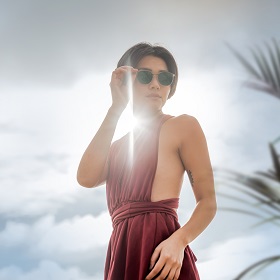Ultra violet light
UVA and UVB rays: the invisible danger for our eyes
As much as we enjoy the sun, over the long term it not only gets to our skin but also to our eyes, especially the invisible UVA and UVB rays. If we look into sunlight without protection, this can damage our retina within seconds. Yet even under a cloudy sky the UV radiation is nearly as high as on sunny days. Sunglasses should therefore always be available to protect the eyes, and your everyday glasses should also have sufficient UV protection.
Double radiation, double danger
Although UV rays do not reach our eyes every day or at every place, radiation is not the same everywhere. It is especially high in the mountains, by the sea or in sunny regions like the Mediterranean. Did you know, for example, that snow reflects sunrays up to 95% and hence nearly doubles them? And that radiation increases by up to 20% with each 1,000 metre cumulative elevation gain as you approach a mountain summit? Or that white sandy beaches have additional radiation of 80%?
Natural eye protection – not always sufficient
The shadows cast by the eye brows, squinting of eyelids, frequent blinking, narrowing of the pupils – all of these are natural mechanisms used by our eyes to protect themselves from the sun. However, if we are outside for the whole day, these are not sufficient, regardless of whether the sun shines or not. In this case the UV rays that fall unimpeded onto the inner eye over a longer period can be very dangerous: macular degeneration (where retinal cells die off), cataracts and corneal burns are possible results of too much UV light, especially in older age, when the hours of sunshine without sunglasses increasingly add up. So take preventive measures early enough and protect your eyes as often as possible with sunglasses or with glasses from optovision, which upon request can be fitted with 100% UV protection.
